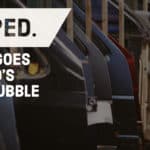Tenth Amendment Center: Pop Goes the Federal Reserve’s Auto Bubble

It looks like the Federal Reserve-induced auto bubble just popped.
Yesterday, GM announced plant closures and layoffs due to sluggish sales. The big automaker said it plans to shutter five North American factories and slash around 14,000 jobs.
The move follows on the heels of an announcement by Ford in October that it will cut an unspecified number of salaried employees. Morgan Stanley speculated Ford may pare more than 20,000 jobs from its global workforce.
According to the New York Times, slowing sales served as a prime driver in GM’s decision to slash its operations.
Part of the retrenchment is a response to a slowdown in new-car sales that has prompted automakers to slim their operations and shed jobs.”
Most people give the sitting president the credit or the blame for what’s going on in the economy. In this case, the current administration does shoulder some of the responsibility for the problems in the auto industry. The NYT also cited the impact of tariffs, particularly the increased cost of steel, as a factor in automaker’s tanking revenues.
But while policies coming out of Washington D.C.do have an impact, by-and-large, Federal Reserve monetary policy drives the economy. And we’re beginning to see the impact of nearly a decade of easy money and credit-driven malinvestment. We already see signs of this as housing bubble 2.0 leaks air.
As the Fed seeks to reverse course and “normalize” interest rates, the auto industry faces a significant problem — the same problem confronting the housing industry. As the New York Times noted, “Rising interest rates are also generating headwinds.”
Real estate and autos are the two sectors in the economy most sensitive to rising interest rates. Most Americans have to borrow money to buy a home or a vehicle. As the cost of borrowing rises, sales will naturally fall.
For nearly a decade, the Federal Reserve held interest rates artificially low. This helped blow up bubbles in both sectors. Easy money did exactly what was intended – it stimulated buying. Now that the Fed is attempting to reverse its policy and “normalize” interest rates, the air has started leaking out of these bubbles.
Signs of problems in the auto sector popped up last spring. At the time, I wrote a report for SchiffGold noting that the air was leaking out of the subprime auto loan bubble. In April, auto loan delinquency rates had already hit levels not seen since 2010 — the height of the Great Recession. I wrote:
The common denominator here: rising interest rates. Easy money pumped up both the housing and auto loan bubble. When the Fed takes away the punchbowl, bubbles burst … In another bad sign for the auto market, subprime borrowers have gone missing from auto showrooms. According to Bloomberg, rising interest rates and rapidly increasing vehicle prices are squeezing consumers with shaky credit and tight budgets out of the market. Even the most creditworthy consumers aren’t showing up to dealerships”
It should come as no shock that seven months later, we’re seeing big auto manufacturers shuttering factories and laying off workers.
The housing and auto industries serve as the proverbial canaries in the coal mine for economies built on credit. The recent downturn in these sectors may well foreshadow an impending recession. We’re seeing rumblings in the stock markets as well. Peter Schiff has been saying we’ve already entered into a bear market. While most of the mainstream pundits continue to view what’s going on as a healthy correction. Schiff said there is nothing healthy about what’s going on.
This is a bubble deflating. This is exactly how it started in 2008, only this is a bigger bubble and it’s going to produce a bigger crisis.”
The Federal Reserve wields a tremendous amount of power. It not only drives the economy, it also backstops all of the unconstitutional federal spending. Without the Fed buying up Treasury bonds using money created out of thin air, the federal government would find it virtually impossible to fund all of its programs and wars.
This is why it’s imperative to support state efforts to undermine the Federal Reserve’s monopoly on money. You can read more about that HERE.
Mike Maharrey
November 27, 2018 at 01:37PM
